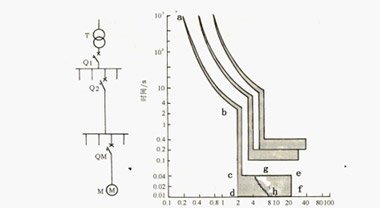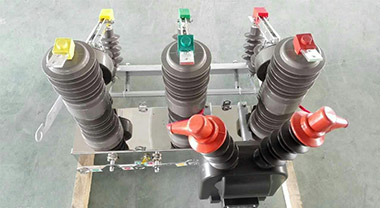Circuit breaker tripping is not necessarily a short circuit
Circuit breaker is a very important electrical appliance in low-voltage power distribution network and electric drive system. It integrates control and multiple protection functions. In addition to completing the contact and breaking the circuit, it can also short-circuit the circuit or electrical equipment. Severe overload and undervoltage protection, and can also be used to start the motor infrequently. There are three situations in which the circuit breaker trips: one is the load is too large, you can change the circuit breaker with a larger load; the other is there is a problem with the circuit, the circuit is grounded, or the circuit meets, which requires professional maintenance. The third is that there are problems with the household appliances at home, so one by one, rule out the problems with the appliances.
What if the circuit breaker trips?
Under no-load condition, check the line voltage and resistance.
- Voltage detection method: The voltage detection method is suitable for detecting whether the circuit has a ground fault. Disconnect the internal live and neutral wires, unplug all electrical appliances, and detect the voltage between the live and internal neutral wires of the external circuit when the circuit is in a fully open state. In general, the open circuit detection voltage value should be less than 5V, and the voltage value is relatively stable. Use AC voltage above 200V, if the detected voltage value is erratic, and the voltage value is less than 240V or between 36~240V (ie combined circuit voltage), according to the physical principle of common electronic circuit series voltage division, judge the detected circuit as a ground fault Circuit (At this time, the neutral wire is equivalent to the ground wire, and the wire resistance is in series with the grounding resistance). The smaller the grounding resistance (that is, the better the grounding), the greater the detection voltage value. Because in general, the grounding resistance is extremely unstable, so the voltage value is also extremely unstable. If the detected voltage value is extremely small (less than 10V) or close to zero (ie, open circuit voltage), the detected circuit can be judged to be a normal circuit.
- Resistance detection method: The resistance detection method is suitable for fully open circuits, that is, the live and neutral wires are all disconnected. This detection method can be used to detect whether the circuit has a short circuit fault. When the internal circuit is fully open, unplug all electrical appliances, and then check the resistance between the internal live wire and the neutral wire and the ground wire. If the detection resistance value is infinite, it can be judged that the circuit is in an open state, and then the tested circuit can be judged to be a normal circuit (healthy circuit); if the detection resistance value is a certain resistance value, it can be judged that the circuit is in a pass state, and the measured circuit can be judged It is a faulty circuit, and there is the greatest possibility of short-circuit fault between the live wire and the neutral wire.
Steps to troubleshoot the line.
- Classification of line groups: match the live line with the neutral line and indicate the line group number.
- Find the faulty circuit group: When the circuit is fully open, the jumper wire and the neutral wire are disconnected, and the voltage value of any neutral wire of the internal circuit and the external live wire is checked across the group to determine the fault point. Detect the voltage between the neutral wire of the detected circuit and the external live wire. If there is a large voltage difference between the external live wire and the internal neutral wire (ie 36V~240V, general lighting voltage), the line group should be classified as a faulty line Group; if the voltage difference between the two is zero or the voltage value is very small (0V-36V, that is, open circuit voltage), the circuit group is a normal circuit (healthy circuit).
- Detect the faulty circuit group: disconnect the neutral line of the faulty line (a good line group should also be in a fully open state), and connect the live line of the faulty line group, that is, only the live line is connected, and the neutral line is disconnected, in the single-pass live line state Next, the fault circuit is detected step by step.
- Detection of leakage fault: If the line is leaking, it cannot be detected with a test pen. The fastest way to detect whether the leakage is to use a megohmmeter (500V meter is optional at home) is mainly to detect the insulation resistance to ground, the detection method : Connect the red test lead to the phase line and the black test lead to the ground line. The insulation resistance value should not be less than 1 megohm. Then connect the red test lead to the neutral line and the black test lead to the ground line. The measurement method is the same.
Testing essentials.
- Use the AC voltage range of the multimeter, and one end is grounded (heating, tap water, or other grounded metal, and make sure not to connect it to the patent leather; if there is 220V, it is a live wire, if it is zero, it may be a neutral wire or a ground wire. There is voltage (even if it is very low, the lowest is generally grounded), and the load must be larger, such as washing machines, microwave ovens, air conditioners, electric heaters, etc.
- No energy fire wire to ground current, only string Measure in the circuit.
- If there is a watt-hour meter, you can disconnect the wiring, and the ground wire is connected to the ground at the back. But you need to understand electrician technology.
- It can measure current, generally live wire and neutral wire have the same current , The current is different, there may be leakage.
- If the ground wire has a voltage to the ground (it is best to measure the current) to prove the leakage. As the ground wire and the neutral wire have the same potential, no voltage will be generated, and no current will be generated.
- Detection 220V line, whether the insulation resistance between live and neutral, live and ground, live and earth is qualified. The insulation resistance of live and neutral, live and earth, live and earth are all infinite. Live and neutral, live and earth The insulation resistance of the ground wire, the live wire and the earth depends on the power cord used. When any two phases (including the ground) are less than 1M, the insulation can be considered damaged and must not be used.




